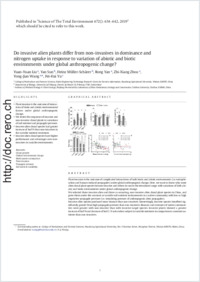Do invasive alien plants differ from non-invasives in dominance and nitrogen uptake in response to variation of abiotic and biotic environments under global anthropogenic change?
- Liu, Yuan-Yuan College of Horticulture and Forestry Sciences, Hubei Engineering Technology Research Center for Forestry Information, Huazhong Agricultural University, Wuhan, China
- Sun, Yan Department of Biology, University of Fribourg, Switzerland
- Müller-Schärer, Heinz Department of Biology, University of Fribourg, Switzerland
- Yan, Rong College of Horticulture and Forestry Sciences, Hubei Engineering Technology Research Center for Forestry Information, Huazhong Agricultural University, Wuhan, China
- Zhou, Zhi-Xiang College of Horticulture and Forestry Sciences, Hubei Engineering Technology Research Center for Forestry Information, Huazhong Agricultural University, Wuhan, China
- Wang, Yong-Jian College of Horticulture and Forestry Sciences, Hubei Engineering Technology Research Center for Forestry Information, Huazhong Agricultural University, Wuhan, China
- Yu, Fei-Hai Institute of Wetland Ecology & Clone Ecology, Zhejiang Provincial Key Laboratory of Plant Evolutionary Ecology and Conservation, Taizhou University, China
-
01.07.2019
Published in:
- Science of The Total Environment. - 2019, vol. 672, p. 634–642
English
Plant invasion is the outcome of complicated interactions of both biotic and abiotic environments (i.e. eutrophication and human-induced propagules) under global anthropogenic change. Here, we want to know why some alien clonal plant species become invasive and others do not in the introduced range with variations of both abiotic and biotic environments under global anthropogenic change.We selected three invasive alien and three co-occurring, non-invasive alien clonal plant species in China, and grew them under the constant or variable soil nutrient environments in a native community with low or high vegetative propagule pressure (i.e. simulating pressure of anthropogenic alien propagules).Invasive alien species produced more biomass than non-invasives. Interestingly, invasive species benefited significantly greater from high propagule pressure than non-invasives. Biomass and evenness of native communities were greater with non-invasive than with invasive target species. Invasive plants showed a greater increase of leaf N and decrease of leaf C: N ratio when subject to variable nutrients in comparison to constant nutrients than non-invasives.The negative effects of variable nutrients on evenness of native communities were significantly greater under invasive than non-invasive target species. Moreover, biomass of native communities was significantly negatively related to biomass of invasive species. Variable nutrients significantly promoted the negative biomass relationship between non-invasive species and native communities under high propagule pressure and the negative biomass-evenness relationship between invasive species and native communities.Our study suggests that soil nutrient variability and vegetative propagule pressure influence the growth and leaf C and N uptake of alien clonal plant species in native experimental communities, especially under the high propagule pressure and nutrient variability. Invasive alien clonal species have higher performance and advantages over non-invasives. Future studies should also test the mechanisms that invasive and non-invasive or native plants differ in native communities of native or introduced ranges in the field.
- Faculty
- Faculté des sciences et de médecine
- Department
- Département de Biologie
- Language
-
- English
- Classification
- Biological sciences
- License
-
License undefined
- Identifiers
-
- RERO DOC 326719
- DOI 10.1016/j.scitotenv.2019.04.024
- Persistent URL
- https://folia.unifr.ch/unifr/documents/307937
Statistics
Document views: 120
File downloads:
- pdf: 243
